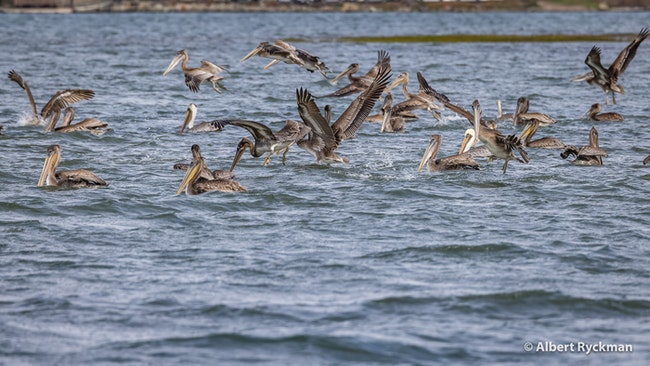
A brown pelican feeding frenzy (Courtesy/Albert Ryckman)
Many birds flock. There are loners, but when you see wild birds, it is often the numbers, the group, the crowd, that impress you.
Now, some parts of the Willamette Valley are a winter bed-and-breakfast for thousands of cackling geese. Local ponds and marshes can host hundreds, even thousands, of ducks. Many of these “wintering” birds spend half their lives here but breed far to the north or east in colder, more extreme climates.
There are two main reasons birds flock together—food and safety. More eyes, more beaks, more searching, the more likely a good food source will be found or utilized. Even birds that can easily find food—say geese looking for lush grass to graze—are safer in a crowd. And all those eyes and ears in a flock are more likely to note approaching danger than a single bird trying to keep watch and eat at the same time.
When you notice hundreds of geese calling and flying, an eagle is likely nearby. A deadly predator, such as a bald eagle or peregrine, finds it hard to pick out a single bird in the swirling, flying chaos of panicked prey. Some birds, such as the crafty crows, appoint a sentinel while the flock feeds.
Flocking birds come in size from our heaviest—tundra and trumpeter swans—down to our smallest songbird, bushtits. Ducks, coots, cormorants, cranes, turkeys, quail, gulls, shorebirds, most sparrows, finches, robins, jays, blackbirds, some flickers, and acorn woodpeckers are flocking birds right now.
The acorn woodpecker outdoes the rest. They live colonially in oak groves year-round. During nesting season the whole tribe puts all its eggs into a single cavity, protects that nest from starlings and then all adults help raise the village young. The flock gangs up to protect its tree trunk full of stored acorns from the jay or squirrel who would steal a meal.
Some smaller birds gather in a cavity on cold nights and share body heat to beat the loss of calories—nuthatches, downy woodpeckers, bushtits.
Food sharing in a flock can be peaceful or cooperative as it often is with shovelers and some other ducks. Or it can be contentious among pine siskins and goldfinches and juncos.
There are solitary birds in winter, mostly predators who disdain any competitor. They range from a tiny ruby-crowned kinglet up to great blue herons and great horned owls. The latter will nest soon so pairs may hoot back and forth for Christmas.
Many flocking birds here for the cold months will be migrating back to nesting territories in spring, together. The sound of northbound geese Is a signal of the seasons recognized across the Northern Hemisphere for millennia.
For information about upcoming Salem Audubon programs and activities, see www.salemsudubon.org, or Salem Audubon’s Facebook page.
Harry Fuller is an Oregon birder and natural history author of “Freeway Birding.” He is a member of the Salem Audubon Society. Contact him at [email protected] or http://www.towhee.net/. His “Some Fascinating Things About Birds” column will be appearing regularly in Salem Reporter.
JUST THE FACTS, FOR SALEM – We report on your community with care and depth, fairness and accuracy. Get local news that matters to you. Subscribe to Salem Reporter starting at $5 a month. Click I want to subscribe!









